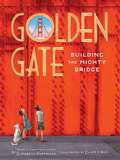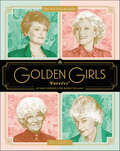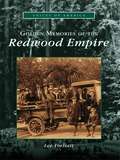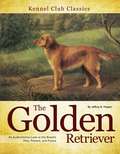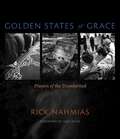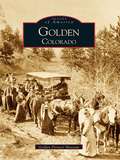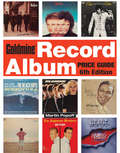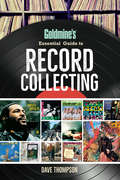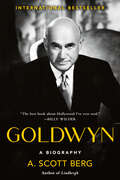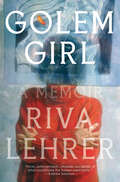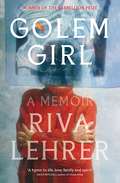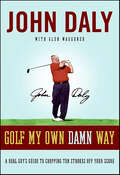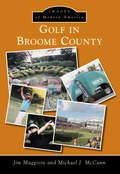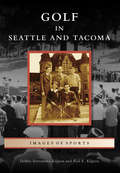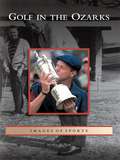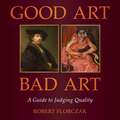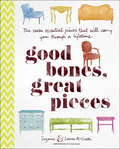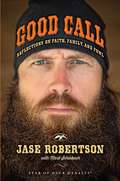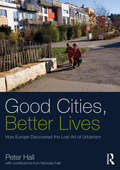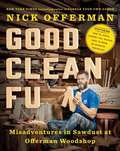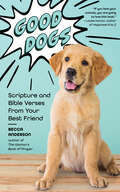- Table View
- List View
Golden Gate: Building the Mighty Bridge
by Elizabeth PartridgeThe Golden Gate Bridge, beloved landmark and symbol of San Francisco, finally gets a gorgeous picture book that tells the thrilling story of how it was built!Across a treacherous strait where deep ocean waters rip back and forth with the tides, and during the depths of the Great Depression, daring teams of engineers and builders set out to make something many thought impossible.Begun in 1933 and officially opened on May 27, 1937, the Golden Gate Bridge and its awe-inspiring and groundbreaking construction are truly a testament to the power of hope and perseverance. Told from the point of view of the lighthouse keeper’s kids, who watch in fascination as the trucks and crews arrive and steel towers coated in heavy red paint begin to rise above the tempestuous water, Golden Gate shares a thrilling visual perspective on each stage of the breathtaking project.Young readers can look and learn as each turn of the page reveals dazzling, color-soaked artwork paired with text that blends factual details into the narrators’ keen observations. By the final spread, where fireworks explode in celebration over the mighty bridge, the tale is complete—not only of an astonishing feat of engineering but of the potential of human ingenuity to defy the odds and make the impossible possible.EXTRAORDINARY NONFICTION BOOK FOR KIDS: Painstaking research went into the writing and illustrating of this story, making it an outstanding resource for learning about an American engineering marvel. The author’s afterword summarizes key facts and offers a powerful reminder of why the Golden Gate is beloved around the world as one of the most beautiful and inspiring bridges ever built.GREAT GIFT: For visitors to the foggy City by the Bay and those who live close to the scenic Golden Gate, this stunning picture book makes a perfect keepsake and tribute to California’s most recognizable landmark.FUN CALIFORNIA HISTORY: A fascinating slice of California history comes alive with detail and drama that will captivate kids of all ages!Perfect for:San Francisco Bay Area locals and visitorsFans of the Golden Gate BridgeTeachers and librarians looking for a nonfiction picture book that teaches history and STEM topicsParents, grandparents, and caregivers seeking engaging nonfiction children’s booksAnyone who has left their heart in San Francisco
Golden Girls Forever: An Unauthorized Look Behind the Lanai
by Jim ColucciIncludes 30 pages of bonus material!The complete, first-ever Golden Girls retrospective, packed with hundreds of exclusive interviews, behind-the-scenes and never-before-revealed stories, more than two hundred color and black-and-white photos, commentary, and more.They were four women of a certain age, living together under one roof in Miami—smart and strong Dorothy, airhead Rose, man-hungry belle Blanche, and smart-mouthed matriarch Sophia. They were the Golden Girls, and for seven seasons, this hilarious quartet enchanted millions of viewers with their witty banter, verve, sass, and love, and reaffirmed the power of friendship and family.Over thirty years after it first aired, The Golden Girls has become a cult classic, thanks to fan fiction, arts and crafts, podcasts, hundreds of fan blogs and websites, and syndication. Now, Golden Girls Forever pays homage to this wildly popular, acclaimed, and award-winning sitcom. Drawing on interviews with the show’s creators, actors, guest stars, producers, writers, and crew members, Jim Colucci paints a comprehensive portrait of the Girls both in front of the cameras and behind the scenes.Illustrated with hundreds of photos, including stills from the show and a treasure trove of never-before-seen and newly rediscovered photos, Golden Girls Forever includes:• Girls and Their Guests: short profiles of the show’s most famous guest stars• Why I Love the Girls: Lance Bass, Laverne Cox, Ross Mathews, Perez Hilton, Zachary Quinto, Chris Colfer, Jason Collins, and many, many other celebrities share their love of the Girls• Exclusive interviews with ninety-four-year-old Betty White; the famously private Bea Arthur and Rue McClanahan, before their deaths; and fan-favorite actors who appeared on the show• Harvey Fierstein's tribute to his close friend, Estelle GettyThe ebook also feautures 30 pages of material not inlcuded in the print edition, such as 17 Golden Episodes, a piece on Estelle Getty's make-up, the Rue LaRue Cafe, and additional fan art.Bursting with fun facts, anecdotes, reminiscences, and insights, Golden Girls Forever is the ultimate companion to the show for fans old and new.
Golden Memories of the Redwood Empire
by Lee TorliattThe high-tech paradise just north of San Francisco, known as the Redwood Empire, was once a land of vineyards, chicken ranches, orchards, and dairies. Using their own words and vintage photographs, here are the stories of the area's residents and their 100 years of history, from the lost glitter of the Gold Rush to end of World War II. The stories recalled here come from the reflections of the people who kept their towns and farms running on a daily basis. Among the voices heard in these chapters are Healdsburg's Ferguson family, pioneer survivors of the westward trail, and David Wharff, who brought the first chickens to Sonoma County, helping create the World's Egg Basket. Through the great Santa Rosa earthquake of 1906, to the devastating flu epidemic of World War I, to the Santa Rosa-Petaluma "Big Game" riot of 1943, these diary, interview, and newspaper accounts cover a century of rich history in the Redwood Empire.
Golden Retriever
by Jeffrey G. PepperFourth in the Kennel Club Books' Classics series, The Golden Retriever recognizes the ever-popular all-American breed in this one spectacular volume. Written by author, breeder, and judge, Jeffrey G. Pepper, this book's engaging chapters on everything from the breed's accomplishments in performance events, to their participation as service dogs make it much more than just "another breed book." With more than 100 vintage and modern photographs of the breed, this book is a must-have for every Golden owner.
Golden Shield: MTC NEXTSTAGE ORIGINAL
by Anchuli Felicia KingTenacious young lawyer Julie Chen brings her sister Eva on board as a translator in a risky legal battle with international ramifications. Leading a class action exposing an American tech giant's involvement with the Chinese government's internet firewall, Golden Shield, they must put their differences aside to confront censorship, mass surveillance, corporate greed and their own complicated past. Loyalty, family and language are tested in this Melbourne Theatre Company NEXT STAGE Original production. Commissioned through MTC's NEXT STAGE Writers' Program with the support of the Playwrights Giving Circle Donors, The Ian Potter Foundation, Naomi Milgrom Foundation, The Myer Foundation, Malcolm Robertson Foundation and The University of Melbourne.
Golden States of Grace: Prayers of the Disinherited
by Rick NahmiasTaking California as a window into the diversity of religion in America, Golden States of Grace documents marginalized communities at prayer in their own faith traditions. The collection is thoroughly interfaith, introducing us to the nation's only halfway house for addicts self-identified as Jewish, a transsexual gospel choir, a Buddhist community in San Quentin, a Mormon congregation organized by the deaf for the deaf, Latina sex workers worshipping the female folk deity Santísima Muerte, and more. Depictions of conventional middle-class religion are widely visible in the media, but the American public rarely sees the sacred worlds of society's marginalized: the outcasts, the fallen, those that have been labeled "other" - ironically, those whom religion aims to serve. The poignant stories Nahmias has gathered here cross numerous boundaries and ask difficult questions few outsiders have been willing to pose.
Golden, Colorado
by Golden Pioneer MuseumWhere The West Lives! Golden's motto sums up the colorful history of the small town set at the entrance to the storied gold fields of Colorado. The scenic valley that shelters Golden caught the notice of some of the most famed pioneers of the West: explorer Major Stephen Long, world traveler Isabella Bird, showman Buffalo Bill Cody, and brewer Adolph Coors. Chronicled here in over 200 vintage images is the history of this quintessential "rough-and-ready" Western town. Serving as the territorial capital from 1862-1867, Golden was primed as the perfect business opportunity due to its proximity to the mining districts. Entrepreneurs with a vision of Manifest Destiny worked diligently to civilize the frontier town, and it soon became a major player in the state's mineral extraction, education, and railroad industries. Boasting more saloons than any other structure in town, Golden also had its share of coal mines, gold smelters, a paper mill, and several railroad lines. Featuring many historic images of the town's past, including original panoramic views by William Henry Jackson and images of Buffalo Bill Cody's Masonic funeral, this book captures the heart of a town where the spirit of the West never died.
Goldmine Record Album Price Guide
by Martin PopoffWhether you're cleaning out a closet, basement or attic full of records, or you're searching for hidden gems to build your collection, you can depend on Goldmine Record Album Price Guide to help you accurately identify and appraise your records in order to get the best price. Knowledge is power, so power-up with Goldmine! 70,000 vinyl LPs from 1948 to present Hundreds of new artists Detailed listings with current values Various artist collections and original cast recordings from movies, televisions and Broadway 400 photos Updated state-of-the-market reports New feature articles Advice on buying and selling Goldmine Grading Guide - the industry standard
Goldmine's Essential Guide to Record Collecting
by Dave ThompsonYour Vinyl Answer Goldmine's Essential Guide to Record Collecting celebrates some of the finest vinyl ever pressed by music's greatest artists. You'll find the royalty of Rock (Elvis, The Beatles, the Rolling Stones), the pioneers of Punk (The Sex Pistols, The Clash, The Ramones), Motown's movers and shakers (Berry Gordy, Marvin Gaye, Gladys Knight), Jazz kings (Charlie Parker, John Coltrane, Dexter Gordon), Disco queens (Donna Summer, Diana Ross, Deniece Williams), the first couple of Folk (Joan Baez and Bob Dylan), and a host of others from Psychedelia, Classical and the Eighties. Filled with record art, concert posters and artist profiles, as well as lists and values of the best rarities, 45s, 78s and albums from across the musical spectrum, Goldmine's Essential Guide to Record Colleting isn't the reason you'll love vinyl. But it just might be the reason your love affair will last.
Goldwyn: A Biography
by A. Scott BergThe legacy of silver screen tycoon Samuel Goldwyn comes to vivid life in this acclaimed biography from the Pulitzer Prize and National Book Award-winning author of Wilson, Lindbergh, and Max Perkins: Editor of Genius.He was the premier dream-maker of his era—a fierce independent force in a time when studios ruled. He was a producer of silver-screen sagas who may have been, in the words of Harper's Bazaar, &“the last Hollywood tycoon.&” In this riveting book, biographer A. Scott Berg tells the life story of Samuel Goldwyn, as rich with drama as any feature-length epic, and as compelling as the history of Hollywood itself.
Golem Girl: A Memoir
by Riva LehrerThe vividly told, gloriously illustrated memoir of an artist born with disabilities who searches for freedom and connection in a society afraid of strange bodies&“Golem Girl is luminous; a profound portrait of the artist as a young—and mature—woman; an unflinching social history of disability over the last six decades; and a hymn to life, love, family, and spirit.&”—David Mitchell, author of Cloud AtlasWhat do we sacrifice in the pursuit of normalcy? And what becomes possible when we embrace monstrosity? Can we envision a world that sees impossible creatures?In 1958, amongst the children born with spina bifida is Riva Lehrer. At the time, most such children are not expected to survive. Her parents and doctors are determined to "fix" her, sending the message over and over again that she is broken. That she will never have a job, a romantic relationship, or an independent life. Enduring countless medical interventions, Riva tries her best to be a good girl and a good patient in the quest to be cured.Everything changes when, as an adult, Riva is invited to join a group of artists, writers, and performers who are building Disability Culture. Their work is daring, edgy, funny, and dark—it rejects tropes that define disabled people as pathetic, frightening, or worthless. They insist that disability is an opportunity for creativity and resistance. Emboldened, Riva asks if she can paint their portraits—inventing an intimate and collaborative process that will transform the way she sees herself, others, and the world. Each portrait story begins to transform the myths she&’s been told her whole life about her body, her sexuality, and other measures of normal.Written with the vivid, cinematic prose of a visual artist, and the love and playfulness that defines all of Riva's work, Golem Girl is an extraordinary story of tenacity and creativity. With the author's magnificent portraits featured throughout, this memoir invites us to stretch ourselves toward a world where bodies flow between all possible forms of what it is to be human.Priase for Golem Girl&“Lehrer&’s story is a revelation of an inner subjective life—full of tragedy, love, and creativity—pushing against the external social stigmas, cultural narratives, and prejudices surrounding disability. She admits a felt kinship with other &“monsters&” because their bodies were also &“built by human hands,&” but unlike them, she is her own purpose, her own meaning, her own unstoppable golem.&”—Stephen Asma, author of On Monsters: An Unnatural History of Our Worst Fears
Golem Girl: A Memoir - 'A hymn to life, love, family, and spirit' DAVID MITCHELL
by Riva Lehrer'A hymn to life, love, family, and spirit' DAVID MITCHELL, author of Cloud AtlasThe vividly told, gloriously illustrated memoir of an artist born with disabilities who searches for freedom and connection in a society afraid of strange bodies.***WINNER OF THE BARBELLION PRIZE***In 1958, amongst the children born with spina bifida is Riva Lehrer. She endures endless medical procedures and is told she will never have a job, a romantic relationship or an independent life. But everything changes when as an adult Riva is invited to join a group of artists, writers, and performers who are building Disability Culture. Their work is daring, edgy, funny, and dark, and it rejects tropes that define disabled people as pathetic, frightening or worthless, instead insisting that disability is an opportunity for creativity and resistance. Riva begins to paint their portraits - and her art begins to transform the myths she's been told her whole life about her body, her sexuality, and other measures of normal.'A brilliant book, full of strangeness, beauty, and wonder' Audrey Niffenegger'Wonderful. An ode to art and the beauty of disability' Cerrie Burnell'Stunning' Alison Bechdel***SHORTLISTED FOR THE NATIONAL BOOK CRITICS CIRCLE AWARD***
Golf My Own Damn Way: A Real Guy's Guide to Chopping Ten Strokes Off Your Score
by Glen Waggoner John DalyIf you know anything at all about John Daly—and if you don't, what in the hell are you doing with this book in your hands?—you know he approaches the game of golf from an, uh, slightly different perspective than your average two-time major winner. How different? Well, for starters, Long John thinks the PGA Tour ought to permit Bermuda shorts, make carts mandatory, let him wear his hair down to his butt if he wants to, and strip-search tournament patrons at the entrance gate to keep cameras and cell phones off the course.In Golf My Own Damn Way, you'll take a virtual ride on Big John's magic bus as he tells you the best way to grip it so you can rip it. Looking for a sure cure to bunkerphobia? It's here. A one-hour golf lesson that's 100 percent guaranteed to make you a better golfer? Ditto. Want to know why you should occasionally leave your big dog in your trunk, how to watch your weight, and what golf and sex have in common? You came to the right book. And while he's busy explaining all these and many other things, Daly also tells you why you should keep your head out of the game, let your belly lead your hands, listen to your right foot, check your ball position—and buy a hybrid (the club, not the car).Following in the spike prints of his 2006 bestselling autobiography, My Life In and Out of the Rough, Golf My Own Damn Way is an off-the-wall and intensely personal yet imminently practical and accessible tip sheet on how to cut ten strokes off your score—now. Two things are certain: you've never seen a golf instructional book quite like this one, and you'll never need another one. Fairways and greens, Pard!
Golf in Broome County (Images of Modern America)
by Michael J. Mccann Jim MaggioreProfessional golf came to Broome County in 1971 as the Broome County Open, a one-day event. By 1973, it had become a four-day stop on the PGA Tour called the B.C. Open. Over the next three decades, it hosted such luminaries of the links as Lee Trevino, Tiger Woods, and Fuzzy Zoeller, while national icons like Bob Hope, Mickey Mantle, and Johnny Hart played in various Pro-Am tournaments. The Dick's Sporting Goods Open began in 2007 as part of the Champions Tour. The sporting goods company got its start in the neighboring city of Binghamton, the hometown of founder Richard "Dick" Stack, making it a natural choice as primary sponsor. The biggest attraction besides golf is the annual Concert on the Green when the 18th green is converted to a stage. Among the major recording artists who have performed are Tim McGraw and the Zac Brown Band.
Golf in Denver (Images of Sports)
by Rob Mohr Edward Mate Leslie Mohr KrupaGolf in Denver looks at the people, places, and events involved in the grand game in the Denver area for more than a century. The photographs in this volume chronicle the sport in Denver beginning in 1896, when it was played nearly exclusively by a handful of socially prominent, wealthy Denverites, to today's popular sport played on dozens of courses dotting the metro area. Casual and avid golfers as well as history buffs will appreciate the stories behind the game, including an in-depth look at how local courses were established, tales of well-known people, and accounts of women and minorities involved in local golf.
Golf in Seattle and Tacoma (Images of Sports)
by Neil E. Kilgren Debbie Sorrentino KilgrenGolf in Seattle and Tacoma uncovers the local history of this sport through photographs and accounts of events that shaped regional courses. In addition to local favorites, lesser-known stories are recounted. Seattle's Bill Wright became the first African American to win a national championship. Ballard's Karsten Solheim invented the PING golf club. Homer Kelley wrote one of the most influential books on the physics of the golf swing. Golf writer John Dreher located kidnapped George Weyerhaeuser. Minority golfers established the Fir State Golf Club to circumvent rules that prohibited entry into golf tournaments. Plus, this book explores the history of the area's newest course, Chambers Bay.
Golf in the Ozarks (Images of Sports)
by Monte McnewIn the early 1900s, southwest Missouri, also known as the Ozarks, quickly became a golfer's retreat. Professionals such as Walter Hagen and the legendary gambler Titanic Thompson toured the area and tested their skills against locals Horton Smith, Ky Laffoon, and others. Over the years, tour professionals including Hale Irwin, Payne Stewart, and Cathy Reynolds developed their games on the Ozark fairways. Today southwest Missouri can proudly claim the winners of five U.S. Opens, three Masters, one PGA Championship, and well over 100 professional tournaments. Golf in the Ozarks will take readers on a tour of "everything golf" in the region, from course and player histories to local tournaments.
Good Art/Bad Art: A Guide to Judging Quality
by Robert FlorczakA manifesto and impassioned plea for artistic excellence When he attended The Cooper Union in the late 1960s, artist Robert Florczak navigated a world of avant-garde experimentation, where modern art reigned supreme. Yet, within this bastion of innovation, and surrounded by cutting-edge, conceptual art, he, along with a few like-minded peers, quietly questioned the legitimacy of the contemporary masterpieces celebrated in the school's corridors and found himself at odds with the prevailing trends. Now, in Good Art/Bad Art, Florczak unveils a critical exploration of the art world, providing a lucid guide for those who believe in the enduring standards of artistic excellence. But Florczak's narrative extends beyond his personal journey. He shines a spotlight on the intimidation faced by art enthusiasts today—a fear to challenge the prevailing elitist "art establishment." Florczak dismantles the arguments for much of today's art, providing common-sense counterpoints to empower those who seek clarity amid the confusion. In a century where art history has been dominated by those distant from the artist's perspective, Florczak advocates for a shift in focus. He argues for acknowledging an Ideal in art, one that transcends history, culture, and passing fads—a visual best that a society can accomplish. Good Art/Bad Art urges us to evaluate art not just through the lens of historians and critics but from the artist's viewpoint. To unravel the mystery of what makes art visually great, Florczak introduces a simple, clear, and rational method for understanding and evaluating art. Rooted in aesthetics, these enduring standards cut through the complexities of "explanations," "statements," and "theories," establishing excellence or exposing artistic missteps.Good Art/Bad Art provides readers with a visual journey, exploring both exemplary and questionable works of art. From the celebrated masterpieces of the past to the often-ignored gems of the present, Florczak delves into the world of art as perceived by its own respective eras. Accompanied by illuminating quotes from artists, his selections aim to provoke thoughtful reflection.Good Art/Bad Art is more than a book—it is a cultural manifesto. Florczak champions the cause of excellence in art, urging readers to defend it with sound, rational arguments. In an era where the art establishment veers towards inanity, offensiveness, and poor execution, this book stands as a guide for anyone who believes in the profound importance of preserving artistic standards.
Good Bones, Great Pieces: The Seven Essential Pieces That Will Carry You Through A Lifetime
by Suzanne McGrath Lauren McGrath&“An excellent and useful book for both beginners and more experienced home decorators . . . Encourages us all to be both carefree and careful&” (Martha Stewart). Making a home is a lifelong pursuit and it starts with your very first place. Suzanne and Lauren McGrath, a mother-daughter team, operate the popular blog Good Bones, Great Pieces. At the core of their philosophy is the belief that every home should have seven essential pieces that can live in almost any room and will always be stylish. The authors explain how to place iconic items of furniture like the love seat and the dresser and rotate them throughout the home as the style or need changes. Illustrated with photographs of homes and apartments that the McGraths have designed, as well as apartments by some iconic designers, this book is a wonderful resource, whether you are starting out with your first apartment or rethinking the design of your home. &“A must-read for first-timers and seasoned home decorators alike.&” —Traditional Home
Good Call
by Jase RobertsonJase Robertson is the straight-faced funny guy of the Robertson clan, stars of the hit TV series Duck Dynasty. In this entertaining new book, he provides a fascinating insight into his personal family life, his childhood days with a drunken father and how he came to discover his faith. There's a delightful mix of hilarious stories and poignant musings on life, as well the 'good calls' he has made. He recalls how, when he went on his first hunt, he saw an excitement in his father Phil that he had never seen in him before; he tells of how he met Missy on an arranged date to make another girl jealous. There are stories of fishing and hunting, as well as the importance of caring for the land on whch we live. If you thought you knew it all about the Robertsons, this book will provide a completely fresh view on them.
Good Cities, Better Lives: How Europe Discovered the Lost Art of Urbanism (Planning, History and Environment Series)
by Peter HallThis book has one central theme: how, in the United Kingdom, can we create better cities and towns in which to live and work and play? What can we learn from other countries, especially our near neighbours in Europe? And, in turn, can we provide lessons for other countries facing similar dilemmas? Urban Britain is not functioning as it should. Social inequalities and regional disparities show little sign of going away. Efforts to generate growth, and spread it to the poorer areas of cities, have failed dismally. Much new urban development and redevelopment is not up to standard. Yet there are cities in mainland Europe, which have set new standards of high-quality sustainable urban development. This book looks at these best-practice examples – in Germany, the Netherlands, France and Scandinavia, – and suggests ways in which the UK and other countries could do the same. The book is in three parts. Part 1 analyses the main issues for urban planning and development – in economic development and job generation, sustainable development, housing policy, transport and development mechanisms – and probes how practice in the UK has fallen short. Part Two embarks on a tour of best-practice cities in Europe, starting in Germany with the country’s boosting of its cities’ economies, moving to the spectacularly successful new housing developments in the Netherlands, from there to France’s integrated city transport, then to Scandinavia’s pursuit of sustainability for its cities, and finally back to Germany, to Freiburg – the city that ‘did it all’. Part Three sums up the lessons of Part Two and sets out the key steps needed to launch a new wave of urban development and regeneration on a radically different basis.
Good Clean Beauty: Over 100 Natural Recipes for a Glowing, Beautiful You
by Caroline Bercaw Isabel BercawEco-friendly, homemade beauty recipes from the teen sisterpreneurs™ and founders of the multimillion-dollar company Da Bomb® Bath Fizzers.Tired of endlessly searching for safe and natural makeup lines free of harsh, chemical-laden ingredients, Caroline and Isabel decided to create their own natural makeup line. Good Clean Beauty includes their thoroughly researched recipes, perfect for those looking for natural and clean alternatives. Using only natural ingredients such as cocoa butter, almond oil, essential oils, and oats, you'll know exactly what you're putting onto your face and body. If you have allergiesor sensitive skin, you'll appreciate and benefit from the non-toxic makeup ingredients.Divided into five parts—hair, body, makeup, eye shadows, and skin care—each section utilizes common items readily available in the kitchen and bathroom that make luxurious scrubs, effective exfoliators, revitalizing face masks, long-lasting foundation, bright eye shadows, shiny lip glosses, and soothing lotions. Also included are tips and tricks of applying makeup, such as foundation, blush, lipstick, and eye shadow, as well as modifications to each recipe. Each ingredient is presented with a short overview of its natural properties and a full explanation on its use and application so that you can learn the healing and therapeutic properties of the ingredients, such as charcoal, arrowroot powder, and nutmeg.Whether you're looking for a resource for spa party or sleepover activities, or creative projects for yourself, Good Clean Beauty has it covered."A practical, effective, comprehensive, and thoroughly ‚Äòuser friendly' instructional guide and manual for women wanting a healthy and eco-friendly approach to their personal hygiene and grooming." ‚ÄïMidwest Book Review
Good Clean Fun: Misadventures in Sawdust at Offerman Woodshop
by Nick OffermanAfter two New York Times bestsellers, Nick Offerman returns with the subject for which he's known best--his incredible real-life woodshop. Nestled among the glitz and glitter of Tinseltown is a testament to American elbow grease and an honest-to-god hard day's work: Offerman Woodshop. Captained by hirsute woodworker, actor, comedian, and writer Nick Offerman, the shop produces not only fine handcrafted furniture, but also fun stuff--kazoos, baseball bats, ukuleles, mustache combs, even cedar-strip canoes. Now Nick and his ragtag crew of champions want to share their experience of working at the Woodshop, tell you all about their passion for the discipline of woodworking, and teach you how to make a handful of their most popular projects along the way. This book takes readers behind the scenes of the woodshop, both inspiring and teaching them to make their own projects and besotting them with the infectious spirit behind the shop and its complement of dusty wood-elves. In these pages you will find a variety of projects for every skill level, with personal, easy-to-follow instructions by the OWS woodworkers themselves; and, what's more, this tutelage is augmented by mouth-watering color photos (Nick calls it "wood porn"). You will also find writings by Nick, offering recipes for both comestibles and mirth, humorous essays, odes to his own woodworking heroes, insights into the ethos of woodworking in modern America, and other assorted tomfoolery. Whether you've been working in your own shop for years, or if holding this stack of compressed wood pulp is as close as you've ever come to milling lumber, or even if you just love Nick Offerman's brand of bucolic yet worldly wisdom, you'll find Good Clean Fun full of useful, illuminating, and entertaining information.From the Hardcover edition.
Good Dogs: Scripture and Bible Verses from Your Best Friend
by Becca AndersonAdorable dog photos paired with iconic Bible verses to warm your heart and give you guidance in times of need. Verses for Daily Meditation. This selection of inspiring, holy words will help you gain a greater understanding on subjects like faith, love, strength, peace, and knowledge. Becca Anderson, author of The Women&’s Book of Prayer and Prayers for Hard Times, knows you&’ll find the truth and hope you need guided by the Lord?and everyone&’s best friend in this Christian dog book.Good Dogs is the perfect Christian inspirational gift. In this book, you&’ll find: Thought-provoking verses for encouragement and meditationClarifying explanations on every pageBeautiful, heartwarming images of all your favorite dog breedsPerfect for readers of What&’s True about You, Zen Dogs, Color the Words of Jesus, or The Psalms in ColorPraise for Good Dogs&“If you love your animals, you are going to love this book. It will remind you that the bond we share with our pets is an expression of divine love.&” —Louise Hamon, author of Happiness A to Z
Good Earth Art: Environmental Art for Kids (Bright Ideas for Learning #2)
by Maryann F. Kohl Cindy GainerFeaturing more than two hundred projects, this guide offers ideas for painting and drawing, sculpture and mobiles, collage and printing, weaving and crafts, and handmade art supplies, all to emphasize recycling and natural materials.
